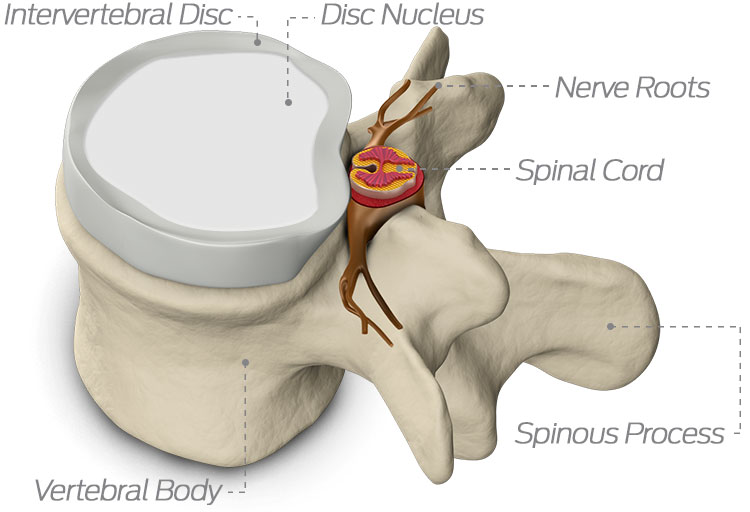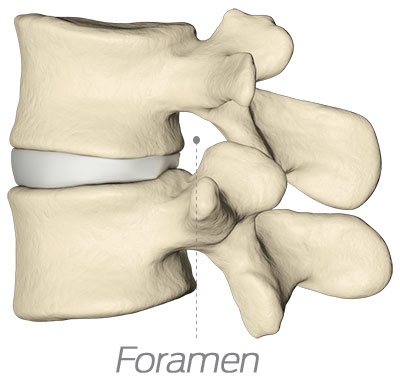In this blog post, you will explore spinal stenosis: what it is, its cause, and how it is treated. You will also learn about cervical spinal stenosis versus lumbar spinal stenosis and get answers to common questions, such as:
What are the stages of spinal stenosis?

Spinal stenosis is the narrowing of the space occupied by the spinal cord, known as the spinal canal. Relatedly, foraminal stenosis is the narrowing of the opening, or foramen, through which the spinal cord’s nerve roots exit the spinal canal. The nerve roots exit the foramen at nearly every level of the spine.
Shock-absorbing discs are found between each vertebral body (the bones that make up your spine), enabling the spine to flex and maintaining the size of the foramen opening. Should these “intervertebral” discs lose height either through trauma—such as accidents— or from degeneration through old age, the foramen can get smaller, compressing the nerve roots that run through them and potentially creating symptoms of pain or discomfort.
Such pain or discomfort can also occur when the spinal cord is compressed by the growth of new bone or the movement of impinging debris into the spinal canal. For example, damaged discs can herniate, pushing gelatinous material out of the center of the intervertebral disc into the spinal canal.
The amount of the impingement on the spinal cord or the nerve roots will determine the severity of the stenosis. Mild stenosis may not cause symptoms of pain or discomfort—also referred to as “asymptomatic”—or the mild stenosis may present symptoms during specific activities. As stenosis worsens, however, generally more severe symptoms may result.

What are the potential symptoms of spinal stenosis and foraminal stenosis?
Symptoms for stenosis can vary—not only depending on the severity of the impingement of the spinal cord or nerve root, but also upon the spinal “level”, or position up and down the spinal column, at which the impingement occurs. Symptoms can range from neck pain to shoulder, arm, or hand tingling—or even lower back or leg discomfort. Severe stenosis, although rare, can even affect balance, create weakness, or result in paralysis.
Nerve roots exit from the spinal cord at nearly every level of the spine. The nerves at each level provide sensory functions to different parts of the body.
The below list shows levels, parts of the body affected, and possible symptoms:
| Vertebral Level: i,ii,iii,iv,v | Provides Sensation To: | Possible Symptoms: |
|---|---|---|
| Cervical Spinal Stenosis | ||
| C1 |
Intracranial Blood Vessels, Eyes, Lacrimal Gland, Parotid Gland, Scalp, Base of Skull, Neck, Muscles, Diaphragm |
Headaches, Migraines, Dizziness, Sinus Problems, Allergies, Head Colds, Fatigue, Vision Problems, Runny Nose, Sore Throat, Stiff Neck, Cough, Croup, Arm Pain, Hand and Finger Numbness or Tingling, Asthma, Heart Conditions, High Blood Pressure |
| C2 | ||
| C3 | ||
| C4 | ||
| C5 | Neck Muscles, Shoulders, Elbows, Arms, Wrists, Hands, Fingers, Esophagus, Heart, Lungs, Chest | |
| C6 | ||
| C7 | ||
| Thoracic Spinal Stenosis | ||
| T1 |
Arms, Esophagus, Heart, Lungs, Chest, Larynx, Trachea |
Wrist, Hand and Finger, Numbness or Pain, Middle Back Pain, Congestion, Difficulty Breathing, Asthma, High Blood Pressure, Heart Conditions, Bronchitis, Pneumonia, Gallbladder Conditions, Jaundice, Liver Conditions, Stomach Problems, Ulcers, Gastritis, Kidney Problems |
| T2 | ||
| T3 | ||
| T4 | ||
| T5 | Gallbladder, Liver, Diaphragm, Stomach, Pancreas, Spleen, Kidneys, Small Intestine, Appendix, Adrenals | |
| T6 | ||
| T7 | ||
| T8 | ||
| T9 | ||
| T10 | ||
| T11 | Small Intestines, Colon, Uterus | |
| T12 | Uterus, Colon, Buttocks | |
| Lumbar Spinal Stenosis | ||
| L1 | Large Intestines, Buttocks, Groin, Reproductive Organs, Colon, Thighs, Knees, Legs, Feet |
Constipation, Colitis, Diarrhea, Gas Pain, Irritable Bowel, Bladder Problems, Menstrual Problems, Low Back Pain, Pain or Numbness in Legs |
| L2 | ||
| L3 | ||
| L4 | ||
| L5 | ||
| Sacrum | Buttocks, Reproductive Organs, Bladder, Prostate Gland, Legs, Ankles, Feet, Toes |
Constipation, Diarrhea, Bladder Problems, Menstrual Problems, Lower Back Pain, Pain or Numbness in Legs |
What are potential spinal stenosis treatments?
As described above, there are many different parts of the spine that can suffer from spinal stenosis. Many people with mild stenosis have no symptoms, but as stenosis progresses can experience increased severity of symptoms. This process may take place over years, or the progression of symptoms can be very rapid—especially if caused by traumatic events.
Treatments for spinal stenosis are typically geared toward managing symptoms so that you can resume an active life. Medications are typically the first tier of treatments. With physical therapy, steroid shots, and surgical interventions indicated if less invasive treatments do not provide needed relief.
The below medications have been used to treat spinal stenosis symptoms:
Physical therapy is often used in conjunction with medications. Physical therapists can teach you exercises that may help to:
Steroid shots may also be used to provide inflammation reduction. These shots are injected directly into the space surrounding a pinched nerve. However, steroid injections may be helpful for only certain symptoms caused by spinal stenosis. Your healthcare provider can tell you if this is an appropriate therapy for your symptoms. There are also drawbacks to using steroid shots, as they may weaken surrounding tissue.
As a final option, surgery can be utilized to relieve symptoms. There are many different surgical options, depending upon the level of the stenosis and the cause of the impingement. These procedures are generally used to relieve pressure on the nerve by removing bone or other tissue. Like all surgical procedures, there may be some risks such as:
What are some things to potentially avoid with spinal stenosis?
Symptoms for spinal stenosis can be worsened by causing additional pressure on the impinged nerves. Therefore, activities that lead to greater inflammation or other stresses on the nerves should be avoided. Activities that can lead to additional inflammation include:
A lack of mobility can lead to inflammation, just as stressing your muscles, tendons, and ligaments can also lead to inflammation. Appropriate exercises, often with guidance by a physical therapist can be used to build strength and tone, but an absolute lack of movement or the wrong form or type of movements can also lead to problems. Once you have symptoms of spinal stenosis, it is important to seek appropriate guidance from trainers who can guide you in selecting the proper activities with appropriate levels of repetition to ensure you improve your health, rather than worsen it.
What are some of the latest treatments for spinal stenosis?
New options to treat spinal stenosis include several minimally-invasive surgical techniques. These procedures potentially enable spinal stenosis to be surgically repaired with minimal damage to surrounding tissue, potentially enabling a quicker recovery from the procedure and lower risks. Your surgeon may be fully versed and experienced in these techniques. It is always best to understand your surgeon’s experience with newer techniques and any drawbacks that may exist.
 About the Author:
About the Author:
Dr. Brooks is a board certified, and fellowship trained orthopedic spine surgeon who specializes in the conservative and surgical treatment of all spinal conditions.
Dr. Brooks interests are in treating mechanical and neurological disorders of the spine. His special interests include complex cervical and lumbar surgery, spinal deformity and instability and disc replacement surgery.
Dr. Brooks is trained in the latest minimally invasive robot assisted techniques for nerve decompression and fusion that provides for shorter hospital stay, less blood loss, hyper-accurate hardware placement and quicker recovery.
These individuals can inspire your journey to healing and life after disc replacement surgery—and the hope of freedom from spine-induced pain and discomfort.
To Find a Spine Surgeon That's Right for You, Use our Surgeon Locator